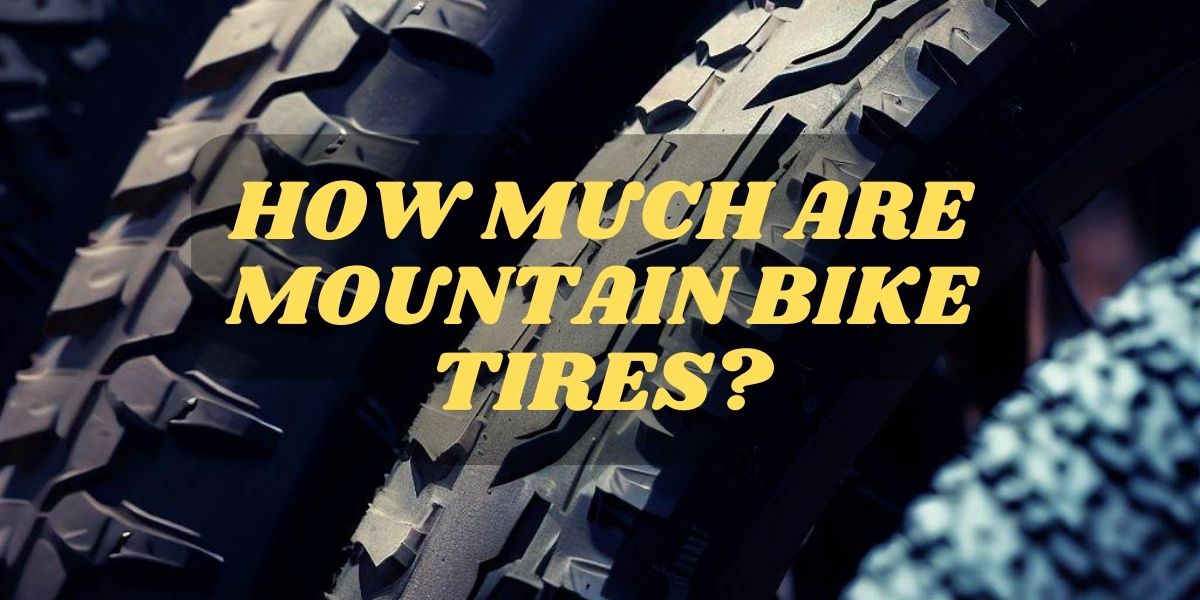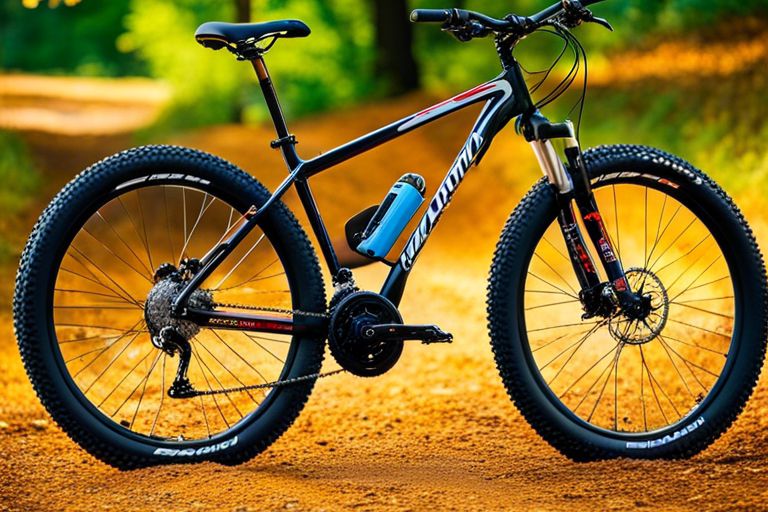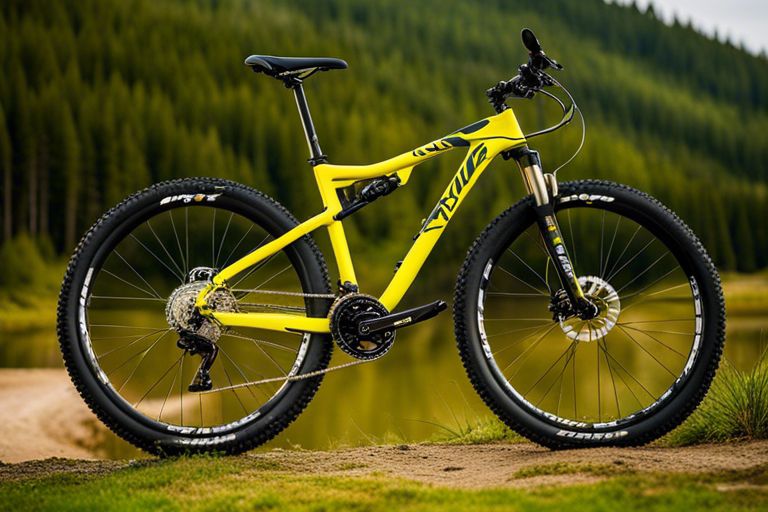Picture this: you’re standing at the base of a mountain, ready to embark on a thrilling ride. Your heart races with excitement as you grip the handlebars of your trusty mountain bike.
But before you can hit the trails, there’s one thing you’ll need to consider: your tires. Like the shoes on your feet, your mountain bike tires are crucial to your performance and safety on the trails.
But how much should you expect to pay for a quality set of mountain bike tires? Well, my friend, that all depends on a variety of factors.
In this article, we’ll explore the different types of mountain bike tires, the factors that affect their cost, and where you can buy them. Whether you’re a seasoned rider or just starting, understanding the cost and maintenance of your tires is essential for mastering the sport of mountain biking.
So let’s dive in and explore the world of mountain bike tires!
Table of contents
Contents
Types of Mountain Bike Tires
You’ll find a variety of awesome options when it comes to choosing the perfect tread for your off-road adventures. Tire tread is critical as it influences how your bike handles different terrain types.
Mountain bike tires come in various tread designs ranging from knobby to semi-slick. Knobby treads are ideal for muddy or loose surfaces, while semi-slicks work well on hard-packed terrain.
Rubber compounds are also a significant factor when choosing mountain bike tires. The rubber compound determines the tire’s durability, grip, and rolling resistance. Soft compounds offer better grip but wear out faster than hard compounds. Hard compounds, on the other hand, have less grip but last longer.
When choosing the right mountain bike tire, it’s important to consider tire tread and rubber compounds. The terrain you’ll be riding on and your riding style will significantly determine which tire is right for you.
In the next section, we’ll explore some factors affecting mountain bike tire costs.
Factors Affecting the Cost of Mountain Bike Tires
There are several factors to consider when considering the cost of mountain bike tires.
The first factor is the terrain and riding style you will encounter. Tires designed for rough, rocky terrain typically cost more than those designed for smoother trails.
Another factor is the level of performance you’re looking for in your tires. High-performance tires with advanced features will generally be more expensive than basic models.
Lastly, the brand and quality of the tire can also impact the price. Well-known, reputable brands with a history of producing quality tires will often have a higher price point.
Terrain and Riding Style
If you love to tackle rough trails and switchbacks, you’ll want to consider the terrain and your riding style when choosing the perfect pair of wheels.
Riding terrain is a crucial factor in determining the type of tire that you should purchase. For instance, if you’re riding on rocky and technical terrain, you’ll need a tire with a larger diameter and a thicker sidewall to withstand the rough terrain.
On the other hand, if you are riding on smoother surfaces, you can opt for smaller tires with a thinner sidewall.
Besides the riding terrain, tread patterns are also essential in determining the cost of mountain bike tires. The tread pattern is the design on the tire that determines how well it grips the ground.
A tire with a more complicated tread pattern will provide better traction and control on loose and slippery surfaces but also come at a higher cost. On the other hand, a tire with a simpler tread pattern will provide less traction but will be more affordable.
Ultimately, it would help if you chose a tire that matches your riding style and the terrain you’ll be tackling.
Performance Level
Let’s explore how the performance level of your tires impacts your overall riding experience. A mountain bike tire’s construction and tread design can greatly affect its performance on different terrains and riding styles.
A tire with a more aggressive tread design and a thicker, more durable construction will typically perform better on rougher terrain and during more intense riding styles, such as downhill or enduro.
On the other hand, a tire with a smoother tread design and a lighter construction may be more suitable for cross-country riding or smoother terrains.
To better understand the impact of tire performance level, let’s take a look at the following table:
| Tire Performance Level | Terrain Suitability | Riding Style Suitability |
|---|---|---|
| Entry-Level | Smooth to Slightly Rough Terrain | Cross-Country |
| Mid-Level | Smooth to Moderately Rough Terrain | Cross-Country to Trail |
| High-End | Smooth to Extremely Rough Terrain | Trail to Enduro |
As you can see, the performance level of your mountain bike tire greatly affects its suitability for different terrains and riding styles.
It’s important to consider your riding needs and preferences when choosing the performance level of your tires. However, it’s also important to consider the brand and quality of the tire, which we’ll explore in the next section.
Brand and Quality
You’ll want to pay attention to the brand and quality of your tires, as it can greatly impact your overall riding experience.
There are many options, but some top mountain bike tire brands include Maxxis, Schwalbe, Continental, and Michelin. These brands have a reputation for producing high-quality tires that can handle various terrains and weather conditions.
Regarding quality vs price, finding a balance that works for you is important. While it may be tempting to go for the cheapest option, keep in mind that lower-priced tires may not last as long or provide the same level of performance as higher-priced options.
However, that doesn’t mean you should always go for the most expensive tire. Consider your riding style and needs, and prioritize quality over price when necessary.
Average Price Range for Mountain Bike Tires
Regarding entry-level mountain bike tires, you can expect to pay anywhere from $20 to $50 per tire. These tires are typically made with lower-grade materials and may provide a different level of performance than higher-end options.
Mid-range mountain bike tires can cost between $50 and $100 per tire, and they’ll balance durability, traction, and weight.
Finally, high-end options can easily surpass $100 per tire. They’re made with the most advanced materials and construction methods for optimal performance.
Entry-Level Tires
Well, aren’t these the bargain-basement rubbers for your two-wheeled off-road adventure machine?
You’ll find options for entry-level mountain bike tires that won’t break the bank but still offer decent performance. These tires are suited for beginners or those who prefer easy trails and occasional off-road rides.
Entry-level tires come in different sizes and tread patterns and are often made of cheaper materials. As a result, tire durability may be compromised, especially when ridden on rough terrains. However, these tires are still a good starting point if you want to upgrade your bike’s tires without spending too much money.
They may provide a different level of grip and speed than mid-range or high-end tires, but they can still handle most trails and offer decent traction in dry and wet conditions. As you gain experience and skills, you should upgrade to better tires that can handle more challenging terrains.
Are you looking for more performance and durability? Step up to mid-range tires.
Mid-Range Tires
If you want to take your off-road adventures to the next level, upgrading your rubbers to the mid-range option will improve performance and durability.
Mid-range tires offer a better balance between weight, grip, and puncture resistance than entry-level options. They also feature more advanced tread patterns and rubber compounds, allowing you to tackle more challenging terrains easily.
Here are four reasons why you should consider investing in mid-range mountain bike tires:
- They have better cornering abilities thanks to more aggressive tread patterns that provide more traction on loose and slippery surfaces.
- They are made from more durable rubber compounds that resist cuts and abrasions, which means they can last longer than entry-level tires.
- They offer better rolling resistance, which translates to faster speeds and less fatigue on your part.
- They come in a wider range of sizes and styles, so you can choose the one that best fits your riding style and terrain preferences.
As you become more skilled and confident on the trails, you may find that you may need more than mid-range tires to meet your needs. If so, it may be time to step up to the high-end options.
High-End Tires
You deserve the best, and that’s exactly what high-end mountain bike tires offer. These tires are designed with cutting-edge technology, including advanced tread patterns and rubber compounds, to provide unparalleled performance, durability, and versatility for your off-road adventures.
The tread patterns on high-end tires are carefully engineered to provide maximum grip, traction, and stability in various terrains, from loose gravel to muddy trails. The rubber compounds used in high-end tires are formulated to provide exceptional durability and resistance to wear and tear, ensuring that your tires will last longer and perform better than lower-end options.
In addition to their superior performance and durability, high-end mountain bike tires offer various other features and benefits. For example, some high-end tires are designed with reinforced sidewalls to protect against punctures and cuts. Others feature lightweight construction for improved speed and agility.
Whether you’re a serious competitor or a casual rider, investing in high-end mountain bike tires is a smart choice that will help you get the most out of your off-road adventures. Now that you know the benefits of high-end mountain bike tires, let’s explore where you can buy them and start planning your next ride.
Where to Buy Mountain Bike Tires
Are you looking for the best places to purchase new treads for your off-road ride? Check out these top spots to snag some fresh rubber.
Whether you prefer to shop online or in person at your local bike shop, these options will have you covered.
Online Options
With the convenience of online shopping, it’s no surprise that plenty of websites offer a wide selection of mountain bike tires. Some popular options include Jenson USA, REI, and Amazon. These sites often have competitive pricing and offer a variety of brands and styles to choose from.
Local Bike Shops
If you prefer to see and touch the tires before purchasing, your local bike shop is a great option. They can provide expert advice on which tires are best for your riding style and terrain and offer the convenience of installation. Plus, supporting local businesses is always a plus!
Chain Retailers
If you’re looking for a middle ground between online shopping and local bike shops, chain retailers like Dick’s Sporting Goods or Performance Bike may be a good option. They typically have a decent selection of tires, and you can often find them on sale.
No matter where you choose to buy your mountain bike tires, it’s important to research and compare prices before purchasing. And once you have your new treads, take proper care of them to maximize their lifespan and performance.
Maintenance and Care of Mountain Bike Tires
There are a few key subtopics to consider when it comes to maintaining and caring for your mountain bike tires.
First, keeping the proper tire pressure is crucial for optimal performance and durability.
Regularly cleaning and inspecting your tires for wear and damage can also help extend their lifespan.
Finally, if it’s time for new tires, consider upgrading to a model that suits your riding style and terrain better.
Prices for mountain bike tires can vary greatly depending on brand and features but expect to spend anywhere from $20 to $100 or more per tire.
Tire Pressure
Maintaining the appropriate amount of air in your MTB tires is like keeping a balloon inflated – too little and you’ll feel sluggish; too much and risk a blowout. The importance of tire pressure cannot be overstated, as it directly affects your bike’s performance, grip, and comfort.
Here are some helpful tips for measuring and adjusting tire pressure:
- Find the recommended pressure range for your specific tire model. This information is usually printed on the tire’s sidewall or can be found online.
- Use a high-quality tire gauge to measure the pressure. Don’t rely on just ‘eyeballing’ the tire, as it can be deceiving.
- Inflate or deflate the tire as needed to reach the recommended pressure. Use a pump with a gauge to ensure accuracy.
- Check the pressure regularly, especially before a ride, as factors like temperature and riding conditions can affect it.
Proper tire pressure not only improves your ride quality but also extends the life of your tires. Now that you know how to measure and adjust it, let’s move on to the next step of tire maintenance – cleaning and inspection.
Cleaning and Inspection
Make sure you give your trusty steed the love it deserves by regularly cleaning and inspecting it to ensure it stays in top condition for all your thrilling adventures.
Cleaning techniques vary depending on the terrain and climate you ride in, but a good rule of thumb is to use gentle soap and warm water to clean off any dirt and grime. Be sure to avoid using harsh chemicals or high-pressure water, as these can damage the tires and other components.
Once cleaned, it’s important to dry everything thoroughly, paying special attention to the chain and other areas where water can collect and cause rust.
When it comes to inspection, it’s crucial to do a thorough check before every ride to ensure your bike is safe and ready to go. An inspection checklist should include checking the tire pressure, brakes, chain, pedals, and other components for any signs of wear or damage.
Look for cracks, frayed cables, loose bolts, or anything else that could cause problems. If you notice anything amiss, take the time to fix it before hitting the trails.
By regularly cleaning and inspecting your bike, you’ll not only extend its lifespan but also ensure a safe, enjoyable ride every time. And if it’s time for tire replacement or upgrades, we’ve covered you in the next section.
Tire Replacement and Upgrades
Now that you’ve cleaned and inspected your mountain bike tires let’s talk about tire replacement and upgrades.
Over time, even with proper maintenance, your tires will eventually wear out and need to be replaced. The longevity of your tires will depend on factors such as the type of terrain you ride on, how often you ride, and the tread pattern on your tires.
You can stick with the same model or upgrade to something new when replacing your tires. Upgrading your tires can provide better performance and grip on the trail.
When choosing new tires, consider the terrain you ride on the most and choose a tread pattern that is suitable for it. For example, riding on loose and rocky terrain, a tire with deeper and more aggressive tread patterns will give you better traction and control.
On the other hand, if you mostly ride on hard-packed trails, a tire with a smoother and shallower tread pattern may be more suitable. Remember that different tread patterns also affect rolling resistance and weight, so choose a tire that fits your riding style and preferences.
See also: How To Maintain A Mountain Bike?
Conclusion
Congratulations on making it to the end of this informative article about mountain bike tires! By now, you should understand the types of tires available, what factors affect their cost, and where to buy them.
But before you run out and purchase your next set of mountain bike tires, let’s take a moment to discuss an interesting statistic. Did you know that the average lifespan of a mountain bike tire is around 600-800 miles? That’s right, even the best tires will eventually wear down and must be replaced.
This is why taking good care of your tires and regularly checking their condition is important. To get the most out of your investment, maintain and care for your mountain bike tires properly. This includes regularly checking for wear and tear, keeping them properly inflated, and avoiding riding on rough terrain that can cause damage.
By following these tips and investing in good tires, you’ll enjoy a smoother, safer, and more enjoyable ride on your mountain bike.







Leave a Reply